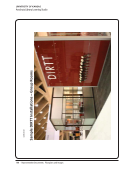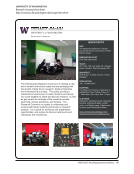18 · Survey Results: Executive Summary
reference questions. Several respondents reported
that librarians’ time had been freed to concentrate on
development of new or additional services.
When asked to describe other types of impact on
permanent library staff, respondents’ varied perspec-
tives were much the same as outlined above. Training
or cross training in procedures and technology was
again the most frequently mentioned impact. Better
use of permanent library staff time was a close
runner-up.
Opportunities for User Participation in the
Planning, Implementation, and Assessment of
Reconfigurations
Questions 14 and 29 asked whether user participa-
tion factored into three phases of a service delivery
reconfiguration: planning, service implementation,
or assessment. Overall, slightly fewer respondents
engage users in various aspects of the reconfiguration
process than don’t. At the libraries that do, users most
frequently participate in planning and assessment
activities.
Planning
Based on the descriptions of methods used to engage
users in the planning process, it is clear that work-
ing with focus groups was the most frequently used
method. Several of the libraries have student or faculty
library advisory groups that were involved at one level
or another in the planning processes. Working with
faculty in specific departments was the method of
engagement most often mentioned when the recon-
figuration involved either the addition or closure of
a branch library. Other methods described included
using LibQUAL+® data, online and in-house surveys,
informal discussions with students, and observation
of use patterns and questions asked.
Service Implementation
Only a few libraries involve users in implementing
service reconfigurations. One library had assistance
from a department for the physical movement of the
collection in a branch library. Other respondents in-
dicated that departments provided funding to hire
students for various aspects of the service implemen-
tation process.
Service Assessment
Perhaps understandably, this category received the
most comments from respondents. By far the most
frequent method used to obtain service assessment
from users was surveys, either library-developed or
including questions on reconfigurations in ongoing
assessments such as the LibQUAL+® or COUNTER
surveys. Libraries reported a varied frequency of de-
livering surveys ranging from six months to three
years. One library performs an annual action-gap sur-
vey for each of its service desks to learn what services
are most valued by users, which those users believe
are accomplished the best, and what areas of service
need improvement. Other methods include using fo-
cus groups, providing comment cards at service desks,
and analyzing various data collected through other
channels.
Respondents reported several different method-
ologies for completed or planned-for assessment of
service reconfigurations. While a few of the service
changes were too new to assess, none of the respond-
ing libraries reported negative reactions from users.
Respondents reported increased usage of collections
and services, users staying longer in visits, and more
favorable/positive comments from users as well as
diminished numbers of complaints. Several of the
respondents provided descriptions of assessment
methods specific to their particular reconfigurations.
Regarding future assessment techniques, respon-
dents reported including assessment of their recon-
figurations in LibQUAL+®, Balanced Scorecard, and
service gap analysis as well as other regular ongoing
assessment activities. Additional methods of assess-
ment included creating focus groups on the recon-
figurations, measurement and analysis of usage data,
user feedback through various mechanisms includ-
ing listening sessions, and anecdotal data from staff
interactions.
Benefits and Challenges of Service Delivery
Reconfiguration
The survey asked respondents about both the associ-
ated benefits and challenges of their service delivery
reconfigurations. In general, the responding libraries
weighed in heavily on the side of benefits that resulted
reference questions. Several respondents reported
that librarians’ time had been freed to concentrate on
development of new or additional services.
When asked to describe other types of impact on
permanent library staff, respondents’ varied perspec-
tives were much the same as outlined above. Training
or cross training in procedures and technology was
again the most frequently mentioned impact. Better
use of permanent library staff time was a close
runner-up.
Opportunities for User Participation in the
Planning, Implementation, and Assessment of
Reconfigurations
Questions 14 and 29 asked whether user participa-
tion factored into three phases of a service delivery
reconfiguration: planning, service implementation,
or assessment. Overall, slightly fewer respondents
engage users in various aspects of the reconfiguration
process than don’t. At the libraries that do, users most
frequently participate in planning and assessment
activities.
Planning
Based on the descriptions of methods used to engage
users in the planning process, it is clear that work-
ing with focus groups was the most frequently used
method. Several of the libraries have student or faculty
library advisory groups that were involved at one level
or another in the planning processes. Working with
faculty in specific departments was the method of
engagement most often mentioned when the recon-
figuration involved either the addition or closure of
a branch library. Other methods described included
using LibQUAL+® data, online and in-house surveys,
informal discussions with students, and observation
of use patterns and questions asked.
Service Implementation
Only a few libraries involve users in implementing
service reconfigurations. One library had assistance
from a department for the physical movement of the
collection in a branch library. Other respondents in-
dicated that departments provided funding to hire
students for various aspects of the service implemen-
tation process.
Service Assessment
Perhaps understandably, this category received the
most comments from respondents. By far the most
frequent method used to obtain service assessment
from users was surveys, either library-developed or
including questions on reconfigurations in ongoing
assessments such as the LibQUAL+® or COUNTER
surveys. Libraries reported a varied frequency of de-
livering surveys ranging from six months to three
years. One library performs an annual action-gap sur-
vey for each of its service desks to learn what services
are most valued by users, which those users believe
are accomplished the best, and what areas of service
need improvement. Other methods include using fo-
cus groups, providing comment cards at service desks,
and analyzing various data collected through other
channels.
Respondents reported several different method-
ologies for completed or planned-for assessment of
service reconfigurations. While a few of the service
changes were too new to assess, none of the respond-
ing libraries reported negative reactions from users.
Respondents reported increased usage of collections
and services, users staying longer in visits, and more
favorable/positive comments from users as well as
diminished numbers of complaints. Several of the
respondents provided descriptions of assessment
methods specific to their particular reconfigurations.
Regarding future assessment techniques, respon-
dents reported including assessment of their recon-
figurations in LibQUAL+®, Balanced Scorecard, and
service gap analysis as well as other regular ongoing
assessment activities. Additional methods of assess-
ment included creating focus groups on the recon-
figurations, measurement and analysis of usage data,
user feedback through various mechanisms includ-
ing listening sessions, and anecdotal data from staff
interactions.
Benefits and Challenges of Service Delivery
Reconfiguration
The survey asked respondents about both the associ-
ated benefits and challenges of their service delivery
reconfigurations. In general, the responding libraries
weighed in heavily on the side of benefits that resulted






















































































































































































































